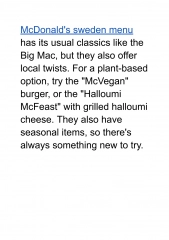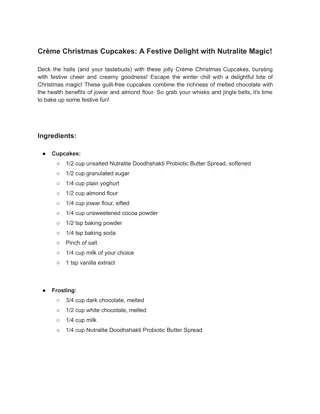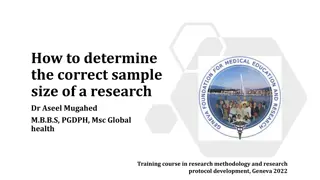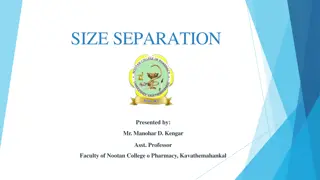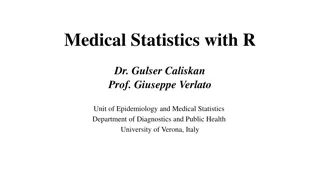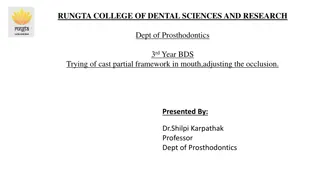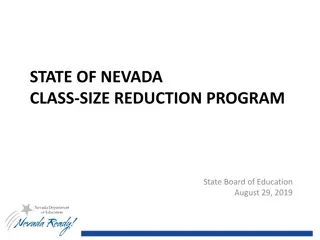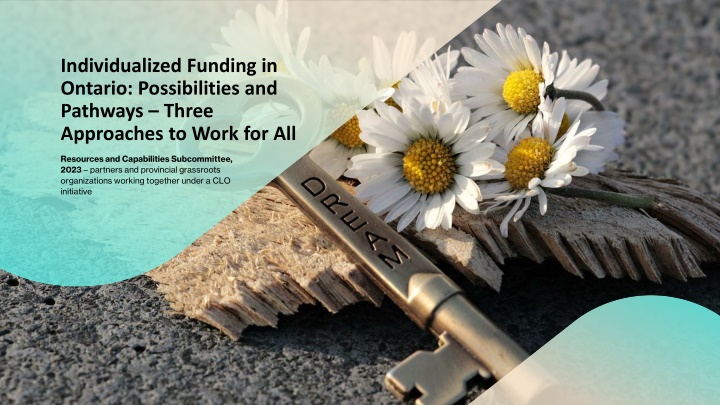
Possibilities and Pathways for Individualized Funding in Ontario
Explore three innovative approaches towards individualized funding in Ontario, focusing on empowering individuals and families, reducing reliance on traditional services, and promoting community-based support. Discover the potential of person/family-led, supported individualized funding, and agency-managed approaches to enhance overall well-being and control in care provision.
Uploaded on | 0 Views
Download Presentation

Please find below an Image/Link to download the presentation.
The content on the website is provided AS IS for your information and personal use only. It may not be sold, licensed, or shared on other websites without obtaining consent from the author. If you encounter any issues during the download, it is possible that the publisher has removed the file from their server.
You are allowed to download the files provided on this website for personal or commercial use, subject to the condition that they are used lawfully. All files are the property of their respective owners.
The content on the website is provided AS IS for your information and personal use only. It may not be sold, licensed, or shared on other websites without obtaining consent from the author.
E N D
Presentation Transcript
Individualized Funding in Ontario: Possibilities and Pathways Three Approaches to Work for All Resources and Capabilities Subcommittee, 2023 partners and provincial grassroots organizations working together under a CLO initiative
Resources and Capabilities Committee Mandate The Resources and Capabilities Committee is a subcommittee of the Inspired By Our Grassroots Steering Committee. This committee was struck to develop and make recommendations on a business model that will lead transformation as identified in Journey to Belonging, in a way that considers the needs of people and families first. This committee reports back to the IOG Steering Committee which ultimately reports back and makes recommendations to the Provincial Executive Directors Group (PEDG), who originally initiated this work in 2013, and its subsequent work plan. Priority #6: Finance business model build practical capabilities Priority #7: Reduce ministry reliance on private, for-profit purchased services
Three Approaches to Work for All
Setting the Context that affects all All people have their own will and preferences which evolve over time Family is defined as chosen family and allies who are unpaid and in a relationship that enables them to recognize and augment the voice of the person Easy and early access to see stories of possibility in real life in community, and to unencumbered third party planning and facilitation Access to the most holistic, least intrusive help with self- regulation, communication and full well-being in all regions is essential Start with the assumption that people can, and want to be, supported in their homes and communities to life a life like all citizens
Three Pathways and Possibilities Person/Family-Led Approach Directing funding to people and their chosen will allow a good number of people to just get on with life and take some pressure off the system, create some good stories going forward, and allow focus to be on many others Supported IF Approach Agency Managed Approach Supported Individualized Funding allows a more level playing field to offer control and direction to remain in the hands of people despite education, life experience, lack of early access to capacity building, etc. It will take pressure off the system as people and their allies will step up as partners to take on a big part of the work. From here new stories of possibility in different life conditions will arise. Agency-managed individualized funding will ensure that the bulk of the current system will not be overturned, but people will be able to look at other options without risking losing their full services. The other two pathways will allow current services to provide support in critical areas not currently being addressed
Elements of the Three Pathways
Person/Family-Led Approach Supported (IF) Approach Agency-Managed Approach Administered: DS Agency Administered: Person, family/trusted others Administered: DS Agency Directed: Person, family/trusted others Directed: DS Agency with direction and involvement of person, family/trusted others Directed: Person, family/ trusted others Who administers the funding?
Person/Family-Led Approach Supported (IF) Approach Agency-Managed Approach Person supported Person supported Person supported For NEW individualized funds, who owns them?
Person/Family-Led Approach Supported (IF) Approach Agency-Managed Approach The person and family choose to receive funding directly from the government and use it to purchase support. The person and family choose to have funding flow through an agency, but the family directs how it is spent, with support and guidelines that are the same as those for a person/family led approach. The person and family choose to send funding to an agency for support of the person. The person can choose to change models over time. The person can choose to change models over time. The person can choose to change models over time. How the funding flows
Person/Family-Led Approach Supported (IF) Approach Agency-Managed Approach Eligible - The parties would develop a contract. Eligible - The parties would develop a contract. Eligible - The parties would develop a contract. Support from a DS Agency?
Person/Family-Led Approach Supported (IF) Approach Agency-Managed Approach Monitoring & Oversight: Given that a person s family and or trusted others are best able to ensure that the person remains safe and is not put at further risk, a new system of accountability measures needs to be developed that are not intrusive but satisfy the need for accountability. These measures must not be unnecessarily onerous and or result in undue financial hardship for families. The goal of these measures is to make it possible to maintain safety and adhere to community standards/law. Monitoring & Oversight: Monitoring & Oversight: See previous column. This is the ideal outcome for this column, using an agency to meet the accountability. QAM would apply. In this context The Ministry may give guidance to both the person and the agency around accountability requirements (financial, safety, etc.,) and together the person and agency agree on how to show this. Guidance and good information are also achieved with the support of an independent facilitator as well as agencies supporting individualized funding options. Accountability
Person/Family-Led Approach Supported (IF) Approach Agency-Managed Approach Yes Yes Not applicable Support from an Independent Contractor?
Person/Family-Led Approach Supported (IF) Approach Agency-Managed Approach Yes Yes Decided by agency Monitoring & Oversight: MCCSS needs to ensure greater or equal oversight as compared to non-profit. Cannot be at a greater cost than a non-profit option. Monitoring & Oversight: MCCSS needs to ensure greater or equal oversight as compared to non-profit. Cannot be at a greater cost than a non-profit option. Monitoring & Oversight: MCCSS needs to ensure greater or equal oversight as compared to non-profit. Cannot be at a greater cost than a non-profit option. Role for a 3rd Party For Profit? Accountability?
Person/Family-Led Approach Supported (IF) Approach Agency-Managed Approach People can choose to move their funding to any other category and across the province. A person/family/trusted others can terminate their contracts any time, subject to the terms they agreed-to, and move their funding. A person/family/trusted others can terminate their contracts any time, subject to the terms they agreed-to, and move their funding. People can choose to move their funding to another TPR in the province. People can choose to move their funding to another TPA in the province. Portability
Person/Family-Led Approach Supported (IF) Approach Agency-Managed Approach Same, plus: Same: People, families, and trusted others have the option for ongoing infrastructure support for unencumbered, 3rd party facilitators. Traditional service agencies should develop a standing partnership with unencumbered facilitation, planning, and brokering groups to assist people to plan (where desired) in an unencumbered way, including away from congregate settings. Purpose: to support a person to explore their vision and to walk alongside them as they take up a purposeful, ordinary life in their neighbourhood and community. Ongoing Unencumbered Facilitation, Planning and Brokering Separate from Program and Service Delivery
Person/Family-Led Approach Supported (IF) Approach Agency-Managed Approach People must be permitted to carry-over a certain amount of funding beyond fiscal year-end in order to responsibly plan for unexpected challenges / flexibility needs. People must be permitted to carry-over a certain amount of funding beyond fiscal year-end in order to responsibly plan for unexpected challenges / flexibility needs. Agencies must be permitted to carry-over a contingency amount in order to ensure flexibility and encourage more individualized supports. Fiscal Flexibility
Additional Issues of Note page 7-8 The role of independent facilitators Independence from the DSO for facilitation and planning, assistance in choice-making, family network support, self-advocacy, capacity building Systems responsiveness for all Return to flexible individualized funding for all children These pathways are not tied to amounts of funds allocated There are effective ways to demonstration real accountability and safeguarding About privatization
We invite you to try these on for size Where can you see you, your family, your agency fitting in here? Looking for your feedback, questions and comments Use the flipcharts around the room Grab and engage one of us in conversation Use the QR code and promise to respond
Pathways and Possibilities Directing funding to people, families, and trusted others together with independently found supports, will allow a good number of people to just get on with life and take some pressure off the system, create some good stories going forward, and allow focus to be on many others. Supported Individualized Funding allows a more level playing field to offer control and direction to remain in the hands of people despite education, life experience, lack of early access to capacity building, etc., and will take additional pressure off the system as people and their families/allies will significantly step up as partners to take on a big part of the work. From here new stories of possibility in different life conditions will arise. Agency-managed individualized funding will ensure that the bulk of the current system will not be overturned, but people will be able to look at other options without risking losing their full services. The relief of pressure from the Person-family-led approach and the Supported/Individualized funding Model will allow current services to provide support in critical areas not currently being addressed (or at risk of being taken over by expensive OPR units).


